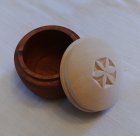Over the weekend I turned a couple of practice boxes out of scrap mystery wood with snug fitting lids. Snug being not quite a pop fit. Today I go out to the shop and I can't get the lids off. The shop is heated to 70 degrees continually but there is no moisture control.
What do you think is the problem? And more importantly how can I solve it? Or better yet How can I sell a box that has a nice fitting lid today, next month the fit is too loose, and six months from now you need a pry bar to get the lid off?
What do you think is the problem? And more importantly how can I solve it? Or better yet How can I sell a box that has a nice fitting lid today, next month the fit is too loose, and six months from now you need a pry bar to get the lid off?

